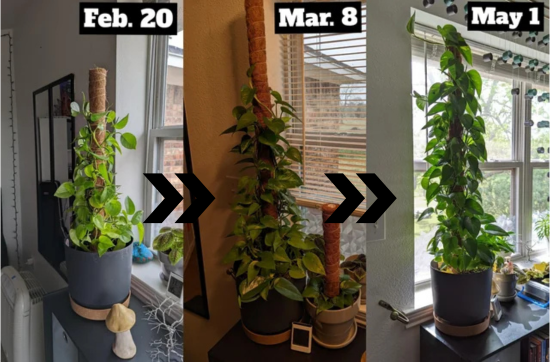When it comes to indoor plants, Pothos (Epipremnum aureum) stands out as one of the most beloved and low-maintenance options. Commonly known as Devil’s Ivy, this versatile vine has earned its place in homes around the world thanks to its vibrant foliage and ability to thrive in a variety of conditions.
What truly sets pothos apart is its adaptability. You can let it Train Pothos to Climb or Trail gracefully from hanging baskets or high shelves, or you can train it to climb walls, moss poles, or trellises for a striking vertical display. This makes it a perfect choice for both compact apartments and spacious homes.
In this guide, you’ll discover:
- How to train your pothos to climb or trail with simple, practical methods
- Styling tips to complement any interior design
- Easy care advice to keep your plant healthy and thriving
Whether you’re a beginner or a seasoned plant parent, this post will help you style your pothos in a way that adds beauty, personality, and greenery to your space.
Why Train Pothos to Climb or Trail?
In their natural tropical habitat, pothos plants are natural climbers. They grow up tree trunks, using aerial roots to grip onto bark as they reach for sunlight in the jungle canopy. This instinctive climbing behavior isn’t just beautiful it’s actually how the plant thrives best in the wild.
So why should you train your pothos indoors? Here are a few compelling reasons:
🌱 1. Encourages Larger Leaves
When pothos are given vertical support like a moss pole or trellis, they often begin to produce bigger, more vibrant leaves just like in the wild. Climbing mimics their natural growth pattern, triggering the plant to grow more robust foliage.
💪 2. Promotes Healthier Growth
Training your pothos to grow upward or in a specific direction helps it distribute energy more efficiently, which can lead to a healthier, more vigorous plant. It also reduces the chances of tangled vines or overly dense patches that can trap moisture and lead to rot.
🪴 3. Enhances Indoor Aesthetics
A well-trained pothos can become a living piece of décor. Whether you guide it along a wall, hang it from the ceiling, or spiral it around a pole, it adds a lush, green vibe that brightens up any room and matches nearly any style from minimalism to boho.
🏡 4. Saves Space in Smaller Homes
If you’re short on counter or shelf space, training your pothos to climb vertically is a smart solution. You can enjoy the plant’s beauty without cluttering your surfaces, making it perfect for small apartments or cozy spaces.
Pothos: Climbing vs. Trailing – What’s the Difference?
One of the reasons pothos (Epipremnum aureum) is such a popular houseplant is its flexibility. You can train it to climb upward like a living vine wall, or let it trail down like a green waterfall. But what’s the difference between the two, and which is right for your home?
🧗♂️ Climbing Pothos: Vertical Drama
Climbing means guiding your pothos upward using support like a moss pole, bamboo trellis, or even hooks along a wall.
Pros:
- Creates a striking vertical focal point
- Encourages larger, mature leaves over time
- Ideal for tight spaces with limited surface area
- Mimics the plant’s natural jungle growth pattern
Cons:
- Needs structural support and occasional tying or guiding
- May require more pruning to maintain shape
🌿 Trailing Pothos: Cascading Elegance
Trailing pothos are left to hang freely whether from shelves, hanging baskets, or plant stands creating soft, lush vines that spill downward.
Pros:
- Perfect for shelves, ledges, or macramé hangers
- Adds a bohemian, relaxed look to any room
- Easy to manage with less need for direction or training
- Great for filling blank vertical wall space or corners
Cons:
- Leaves may stay smaller if not climbing
- Can get tangled or messy if not trimmed occasionally
🏡 Which One Fits Your Space and Lifestyle?
Ask yourself:
- Do you have vertical space but limited floor or shelf room? → Go for climbing.
- Want something low-effort and naturally flowing? → Try trailing.
- Like to experiment or redecorate often? → Start with trailing and train it to climb later!
Whether you prefer a climbing pothos that reaches for the ceiling or trailing vines that cascade beautifully down furniture, there’s no wrong choice just what fits your style and space best.
How to Train Pothos to Trail Naturally
If you love the look of flowing green vines, training your pothos to trail naturally is a beautiful and easy way to add life to your home. Whether it’s cascading from a bookshelf or hanging in a sunny window, a trailing pothos can instantly soften any space.
🪴 Ideal Locations for Trailing Pothos
To make the most of your plant’s trailing habit, choose spots that allow vines to hang freely:
- Hanging baskets in front of windows or in empty corners
- Wall-mounted planters for a modern, vertical look
- Shelves, bookcases, or cabinets where vines can drape gracefully down
These locations not only highlight the beauty of the trailing vines but also save floor space and add natural decor to unused areas.
🌱 How to Guide Vines Downward
While pothos naturally trail, a little guidance can help shape them more neatly:
- Gently drape vines in the direction you want them to grow
- Use gravity to your advantage place vines over edges so they fall naturally
- Avoid abrupt direction changes to keep the look soft and organic
✂️ Tips to Prevent Tangling
Trailing vines can become tangled or messy if not cared for. Here’s how to avoid that:
- Space the vines apart when arranging them on shelves or planters
- Untangle and reposition vines during watering or regular plant care
- Rotate the pot occasionally to keep vines from clumping on one side
🧩 Use Decorative Wall Hooks or Pegs
For added charm and structure, try using small wall hooks, pegs, or plant clips to guide your pothos:
- Create a flowing design along the wall
- Help manage direction and prevent tangling
- Add a personal touch with hooks that match your decor
This is especially useful if you’re working with a small space or want a more artistic look.
🌿 Pruning for Shape and Growth Balance
Don’t be afraid to trim your pothos! Pruning:
- Keeps vines from getting too long or straggly
- Encourages bushier growth near the base
- Helps maintain a balanced, clean look
Use clean scissors and always cut just above a leaf node to promote new growth.
How to Train Pothos to Climb Upwards
Want to turn your pothos into a stunning vertical statement piece? In their natural habitat, pothos vines climb up trees and tall surfaces and with the right support at home, they can do the same indoors. Here’s how to train your pothos to climb and thrive.
🪵 Best Support Tools for Climbing Pothos
Start by choosing the right support for your plant. Here are some great options:
- Moss poles – Great for mimicking the natural environment; helps aerial roots attach and absorb moisture.
- Coir poles – Similar to moss poles, but made from coconut fiber and usually longer-lasting.
- Wooden stakes – A simple and affordable solution for small or young pothos plants.
- Trellises – Ideal for decorative displays or growing multiple vines in a pattern.
- Command hooks or adhesive wall clips – Perfect for training vines up walls without damaging paint or surfaces.
Each of these tools gives your pothos the structure it needs to climb upward and grow more robust leaves.
📋 Step-by-Step Guide to Training Pothos to Climb
Follow these simple steps to help your pothos grow vertically:
1. Choose the Right Support
Pick a moss pole, trellis, or wall setup based on your space and aesthetic preferences.
2. Moisten the Pole (If Using Moss or Coir)
Spray the pole with water before use. This helps attract aerial roots and mimics the plant’s natural climbing environment.
3. Gently Tie the Vines
Use soft plant ties, garden twine, or velcro strips to secure vines loosely to the support. Be careful not to tie too tightly you don’t want to damage the stems.
4. Encourage Aerial Roots to Attach
As pothos vines develop aerial roots, guide them to touch and grip the surface of your support. With time, they’ll naturally cling and grow upward.
Reposition and retie the vines as they grow to maintain shape and direction.
☀️ Light & Humidity Tips for Better Climbing
To get the most out of your vertical-growing pothos:
- Bright, indirect light encourages stronger, fuller vines.
- Rotate the plant occasionally so all sides receive equal light.
- Increase humidity by misting the plant or using a humidifier this helps aerial roots attach and grow more effectively.
High humidity is especially helpful if you’re using moss or coir poles, as it keeps the pole moist and promotes root attachment.
Common Mistakes to Avoid When Training Your Pothos
Training your pothos to climb or trail can be rewarding, but a few simple mistakes can hold back its growth or even damage the plant. Here are the most common issues to watch out for and how to avoid them.
❌ 1. Over-Tightening Ties
When securing vines to a pole or support, it’s important to tie loosely. Tight ties can cut into the stem and restrict growth, or worse, cause permanent damage. Use soft ties like garden twine, velcro strips, or fabric strips, and always leave some room for the vine to move and expand.
🌤️ 2. Ignoring the Direction of Light
Pothos naturally grow toward the light, so if your light source is only coming from one side, your plant may become lopsided or sparse on the opposite side. Rotate your plant every week or two to keep growth even and balanced.
🪴 3. Letting Vines Grow Too Long Without Support
If vines are left to sprawl for too long without guidance, they may become tangled, leggy, or damaged. Start training your pothos early so you can shape it gradually. This also makes it easier for aerial roots to find and grip onto a support.
💧 4. Using Dry Moss or Coir Poles
Dry moss or coir poles won’t attract aerial roots the way moist ones will. Before tying your vines, mist or soak the pole to create a more inviting environment for root attachment. Keeping it slightly damp helps the plant cling better and grow faster.
✂️ 5. Neglecting Pruning
Pruning isn’t just for looks it’s essential for encouraging bushier, healthier growth. Regularly trim overly long or damaged vines, and pinch back stems to promote new leaves and branching. Without pruning, your pothos may grow long and thin, with sparse leaves.
Care Tips to Support Your Trained Pothos
Training your pothos to climb or trail is just the beginning. To keep your plant healthy, vibrant, and thriving in its new form, consistent care is essential. Here are some care tips tailored specifically to support your trained pothos:
💧 Watering Schedule
Pothos plants prefer their soil to dry out between watering sessions. Overwatering can cause root rot, while underwatering leads to droopy leaves. A good rule of thumb is to water your pothos when the top 1-2 inches of soil feel dry to the touch. During warmer months, this may be once a week, and less often in cooler seasons.
🌿 Fertilizing Routine
To encourage lush foliage and strong growth, feed your pothos with a balanced, water-soluble fertilizer every 4-6 weeks during the growing season (spring and summer). Avoid fertilizing in winter when the plant’s growth naturally slows down.
🧽 Cleaning Leaves
Dust and grime can accumulate on leaves, blocking sunlight and reducing photosynthesis. Gently wipe the leaves with a soft, damp cloth every few weeks to keep them shiny and healthy. This is especially important for climbing pothos whose leaves are more exposed.
✂️ Pruning for Bushiness
Regular pruning not only maintains shape but also promotes bushier growth. Pinch back long vines and trim any yellowing or damaged leaves to keep your pothos looking fresh and vibrant. This encourages new shoots to sprout and fills out your plant nicely.
🔄 Rotating the Plant for Even Light
Since pothos grow toward light, rotating your plant every 1-2 weeks helps ensure even growth on all sides. This is especially crucial for climbing pothos trained on one side of a pole or trellis, to prevent uneven or lopsided development.
Creative Styling Tips for Home Decor with Pothos
Pothos plants aren’t just easy to care for they’re also incredibly versatile when it comes to styling your home. Whether you prefer the elegant climb or gentle trail, here are creative ways to showcase your pothos and elevate your living space:
🌿 Where to Place Climbing Pothos
Climbing pothos make a stunning vertical statement and work beautifully in corners or areas that benefit from height. Try these spots:
- Near bookshelves: Let your pothos climb up a trellis or pole next to a bookshelf, adding lush greenery that brings warmth to your reading nook.
- Behind headboards: Place a climbing pothos behind or around your bed’s headboard for a natural, calming backdrop.
- Living room corners: Use a tall moss pole or trellis in an empty corner to fill vertical space elegantly.
🍃 Where to Place Trailing Pothos
Trailing pothos have a soft, cascading beauty that suits spots where greenery can spill naturally. Ideal locations include:
- Kitchen countertops or shelves: Add freshness and life to your kitchen by placing trailing pothos in hanging baskets or wall-mounted planters.
- Bathroom shower shelves: The humidity in bathrooms helps trailing pothos thrive, and their draping vines add a spa-like vibe.
- Window sills or plant stands: Let the vines gently cascade off shelves or stands, creating a relaxed, natural atmosphere.
✨ Pairing Pothos with Other Décor Elements
Elevate your plant styling by pairing pothos with complementary décor:
- Fairy lights or LED strips: Wrap gentle string lights around climbing supports or hang them near trailing vines to add a magical glow.
- Decorative pots: Choose pots in natural materials like terracotta, ceramic, or woven baskets that match your room’s aesthetic.
- Picture frames or mirrors: Position pothos near wall art or mirrors to create depth and soften harsh lines with organic shapes.
🌱 Space-Saving Vertical Garden Idea
If you’re short on floor space, consider creating a vertical garden wall using multiple moss poles or trellises. This not only maximizes space but creates a vibrant green feature wall that’s both functional and stunning.
Frequently Asked Questions About Training Pothos
1. How long does it take to train pothos to climb?
Training pothos to climb usually takes several weeks to a few months, depending on the plant’s age, growth rate, and environment. Younger plants might take longer as they establish aerial roots and adjust to the support structure. With consistent care, proper lighting, and regular encouragement (like gently tying vines), you’ll start to see vertical growth within 4 to 8 weeks.
2. Can pothos grow up a wall without a pole?
Yes, pothos can grow up a wall without a pole, but it often needs some form of assistance to grip surfaces. Pothos use aerial roots to attach to rough textures like brick or wood. However, smooth walls can be challenging for them to climb naturally. Using adhesive hooks, trellises, or textured supports can help your pothos vines anchor and climb more easily.
3. Is pothos better as a hanging or climbing plant?
Whether pothos is better as a hanging or climbing plant depends on your space and aesthetic preferences. Climbing pothos create dramatic vertical interest, perfect for corners or small spaces. Hanging pothos offer a soft, cascading look that works well on shelves or in hanging baskets. Both styles bring unique charm choose based on your home layout and personal style.
4. What’s the best support for pothos vines?
The best support for pothos vines includes moss poles, coir poles, wooden stakes, and trellises. Moss poles are especially popular because they retain moisture, encouraging aerial root growth. For wall-mounted displays, Command hooks paired with trellises or string supports work well. Make sure to choose a support that matches your plant’s size and your décor.
5. Do pothos need light to climb properly?
Yes, pothos need adequate indirect light to climb properly and maintain healthy growth. While they tolerate low light, brighter indirect light encourages stronger, faster climbing and larger leaves. Position your climbing pothos near windows with filtered sunlight to support vigorous growth and vibrant foliage.
Conclusion
Training your pothos to climb or trail not only enhances its natural beauty but also adds a unique touch to your home decor. Whether you prefer the dramatic vertical presence of climbing vines or the graceful, cascading charm of trailing pothos, both styles offer exciting ways to showcase this versatile plant. Experimenting with different training techniques can help you discover what works best for your space and lifestyle.
We’d love to hear about your pothos journey! Share your styling tips, questions, or photos in the comments below.
Ready to take your pothos care to the next level? Sign up for our email newsletter for exclusive plant care tips, or explore our curated collection of support accessories to help your pothos thrive. Don’t forget to check out more of our plant care guides to keep your green friends healthy and happy!
Check Out this Content Also-Top 7 Types of Pothos Plants to Grow Indoors in the USA





Leave a Reply